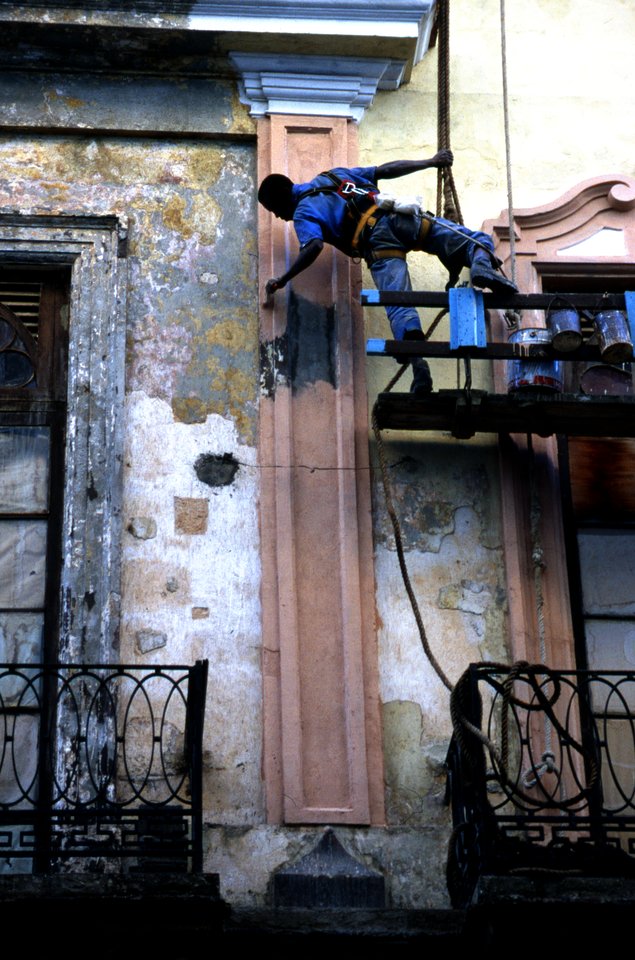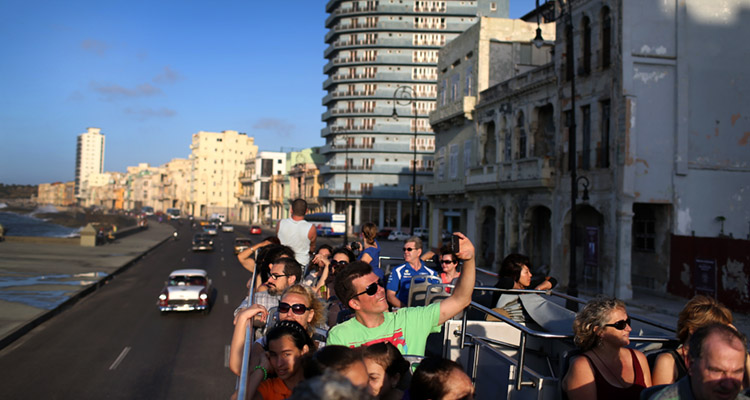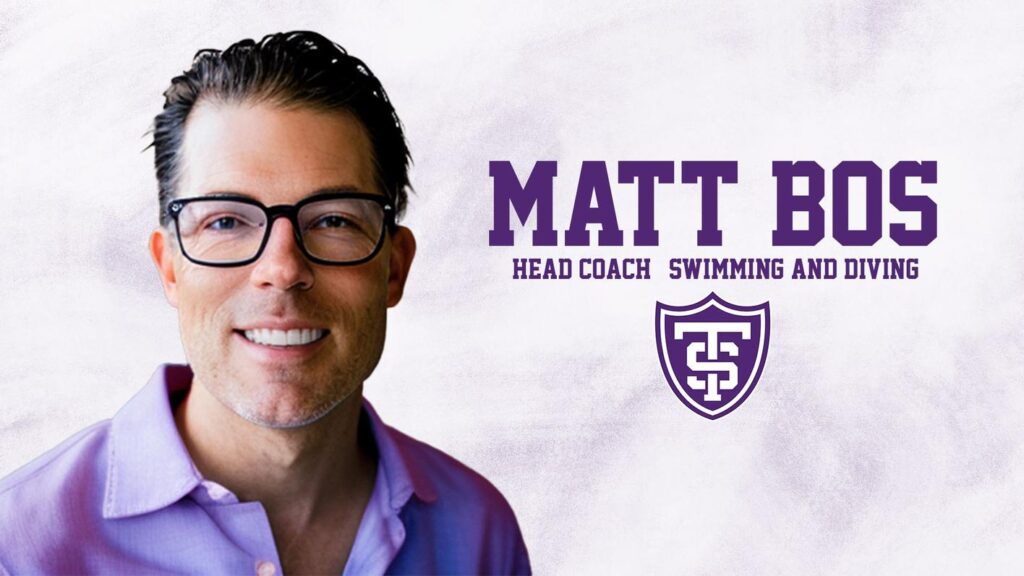On Wednesday, Dec. 17, 2014, I was in my room in Hotel El Presidente in Havana, Cuba, when the scroll on CNN International read “Obama to announce Cuba policy overhaul at noon.” Wow, what timing!
My husband, Bill Flanigan, and I were in Havana to participate in a series of discussions with Cuban and U.S. scholars on “The Future of U.S.-Cuban Relations in the Last Two Years of the Obama Administration.”
The discussions recessed at noon to listen to the parallel speeches by President Barack Obama and President Raul Castro. The afternoon meetings were canceled in celebration. Many of us said it was a good thing the announcement was made on the final day of our meetings, because it immediately made everything said obsolete.
Was this a surprise? You bet. Just the evening before we all had attended a tribute to Wayne Smith, the head of the U.S. Interest Section in Havana from 1979-82, who had resigned from the Foreign Service during the Reagan administration to protest U.S. policy toward Cuba (and has worked since to change it).
The evening was organized by Josefina Vidal, the director general for the United States in the Cuban Ministry of Foreign Relations. Vidal is now the lead negotiator for the Cuban side in the bilateral talks to normalize relations. One of the (many) speakers at the tribute was the wife of Ramón Labañino, one of the Cuban Five still in prison in Florida who would be released in the prisoner exchange the next day.
During a lengthy evening of speeches by Cuban dignitaries, only one small, vague and largely unnoticed hint was dropped about the possibility of change in the near future. Our meetings were hosted by the Center for Research in International Politics (CIPI), the academic arm of the Cuban Ministry of Foreign Relations, but our Cuban counterparts seemed as clueless about these unfolding events as we Americans.
The mood in Havana was one of cautious optimism, with unmitigated joy over the return of the remaining members of the Cuban Five, who are regarded as Heroes of the Revolution. Conversely, we recognized other potential policy openings in the past have come to naught.
In St. Thomas’ 16-year engagement with Cuba, we have been through some of those ups and downs, with varying consequences for our activities and programs.
Tommies in Cuba
In January 1999, then-President Father Dennis Dease and Miriam Williams, associate vice president for academic affairs, led a delegation of 17 St. Thomas faculty and administrators to the University of Havana and the Polytechnic Institute José Antonio Echevarría.
These initial contacts led to fruitful individual connections, some of which continue today, and it also set the stage for the “baseball exchange” that occurred a year later. The St. Thomas baseball team traveled to Cuba in January 2000 and the University of Havana team came to Minnesota the following May. Dease and University of Havana Rector Dr. Juan Vela Valdés also signed a formal academic exchange agreement during the January 2000 trip.

Jake Mauer poses with a Cuban baseball player during the Tommie baseball teams' 1999 trip to Cuba. (Photo by Roger Rich)
The next four years saw vigorous activity in the exchange program. During that time, nine J-Term, summer and embedded spring break undergraduate and graduate classes were conducted in Cuba by St. Thomas faculty – in computer science, biology, history, theology, education and Spanish. St. Thomas faculty members offered lectures and workshops in GIS systems and software engineering. The Concert Band included Cuba in its performance tour of the Caribbean. Trustees and donors took medical supplies to Cuba and explored the art and architecture of Havana and other Cuban sites. Numerous Cuban scholars visited St. Thomas for a few days or as long as a semester. (Four Cubans, in the United States for meetings of the Latin American Studies Association, were stranded at St. Thomas for several days after Sept. 11, 2001.)
This robust activity reflected, in part, the state of relations between the United States and Cuba at that time. Cuba just was emerging from its Special Period, occasioned by the fall of the Soviet Union, a time when the economy was near collapse. The Cuban government looked to increase tourism and introduced a dual currency to attract and control the use of hard currency.
Even though the U.S. Congress had passed, and President Bill Clinton had signed into law, the Helms- Burton Act in 1996, further cementing the U.S. embargo against Cuba, migration talks had resulted in agreements to return fugitives to their countries.
The Elián Gonzalez episode, although a tense time – during which both halves of the baseball exchange took place – found ordinary Cubans pleased the U.S. government ultimately did the right thing and returned Elián to his father.
Carrying on academic exchange in this climate was not easy. The U.S. embargo required a number of conditions that had to be complied with or worked around. There was no direct mail service to Cuba; all financial transactions had to be in cash; telecommunications were primitive; and educational activities, sports activities and other economic transactions required special licensing from the U.S. Department of the Treasury. Still, licenses were applied for and granted, and the exchange flourished.
A sudden, challenging shift
 The 2004 election, with Florida’s electoral votes in play, possibly played a critical role in the June 2004 changes. The Bush administration tightened the regulations under which the Treasury Department allowed travel to Cuba for educational purposes.
The 2004 election, with Florida’s electoral votes in play, possibly played a critical role in the June 2004 changes. The Bush administration tightened the regulations under which the Treasury Department allowed travel to Cuba for educational purposes.
The new requirements specified that courses offered in Cuba needed to be at least 10 weeks in length (eliminating J-Term courses, summer courses and week-long study abroad opportunities embedded in semester courses at the home institution).
All students in such programs were required to be degree-seeking students at the institution offering the course (eliminating all programs run by consortia of schools).
Together, these two provisions effectively shut down all academic courses offered by U.S. institutions. No institution reliably could find 15 to 20 of their own students interested in a full quarter or semester to study in Cuba.
The other half of the exchange – the flow of Cubans to the United States – also was effectively turned off. The Cuban government always had been reluctant to allow undergraduate students to come to the United States under the exchange. (The baseball exchange had been an exception – but the defection of the Cuban second baseman from the team illus- trates the reason for the Cubans’ concern.) But, as noted above, Cuban faculty members regularly had come for periods up to a semester to give lectures or do research at St. Thomas.
Along with the tightening of regulations by the Treasury Department, the State Department began to regularly deny visas to Cuban scholars coming to U.S. universities or attending international conferences such as the Latin American Studies Association’s meetings.
In this environment, St. Thomas tried to keep the spirit of the exchange alive. We kept our Treasury license for educational activities in Cuba current, even though it was virtually impossible to have any such educational activities. We continued to offer official invitations to Cuban scholars, despite knowing their visas would be denied. We cooperated in developing a lawsuit challenging the regulations, even though it was ultimately decided not to become a party to the suit. I made several trips to Havana to give talks on U.S. politics, to meet with Cuban colleagues and administrators at the University of Havana, and to remind them they were not forgotten.
As time went on and more Cuban scholars were denied visas, the Cuban university officials began to deny permission for them to apply – an interview at the U.S. Interests Section in Havana costs $100 U.S.; the average monthly salary of a faculty member is the equivalent of $30 U.S. The University of Havana simply couldn’t throw away that kind of money on a process that seemed destined to fail.
When this happened, St. Thomas – and I believe we were the only university to do this – offered to pay the interview costs for those scholars we wanted to invite to visit us. An insurmountable cost for the Cubans; a small price for St. Thomas. As a result, when, in August 2008, the State Department issued visas to Cubans again, St. Thomas had two invited scholars in the pipeline able to be on campus fall semester 2008.
A welcome change
Why the abrupt change? Who knows? Perhaps the State Department saw the handwriting on the wall for the November election. In any event, in 2009 the Treasury Department issued new regulations regarding travel to Cuba. The biggest changes had to do with family visits, greatly increasing the ease and frequency with which Cuban-Americans could visit family in Cuba. These new regulations also relaxed restrictions on travel for educational purposes.
Gone were the onerous requirements that prevented short courses and consortia arrangements. Accredited institutions now could conduct educational programs under a general license from the Treasury (that does not need to be applied for), rather than applying for a specific license that might be subject to bureaucratic delays or denials. Full-time and part-time faculty and administrators may travel under the general license for allowed educational purposes.
Under the liberalized 2009 regulations, St. Thomas’ engagement with Cuba began to revive. In January 2014, professors Don Miller and Sonia Rey Montejo of the Department of Modern and Classical Languages led 18 students in an Ethnicity, Multicul- turalism and Globalization in Cuban Society J-Term course in Havana. Professor Adam Kay of the Biology Department and professor Father Jean-Pierre Bongila of the Department of Leadership, Policy and Administration have traveled to Cuba to explore the possibility of conducting courses there.
In 2013, the Raul Castro regime eliminated the requirement that Cubans apply for exit visas to leave Cuba. This change swiftly led to St. Thomas welcoming our first undergraduate exchange student from Cuba and the first Cuban recipient of the Lee and Penny Anderson Scholarship for Caribbean Students, Giselle Garcia Castro, who attended St. Thomas for the 2013-14 academic year.
Potential and caution
The announcements of Dec. 17, 2014, and new regulations issued by the Treasury quickly thereafter, didn’t change the situation for our exchange programs much – except perhaps to make the competition for seats on the few charter flights to Cuba more intense. Faculty will be able to attend conferences in Cuba more easily – and they will now be able to bring back $100 worth of Cuban cigars and rum! The greater significance is in the signaling of a changed mindset – in Washington, in the media, in the business community, in the general public – that it’s time to think differently about this neighbor 90 miles to our south, and to engage with that nation in a different way.

Havana in 1999. (Photo by Roger Rich)
The road ahead certainly will have some bumps and detours. President Obama’s announcement and the executive actions he can take have changed the conversation and can lift a number of restrictions on commercial and financial transactions. Removing Cuba from the State Department’s list of state sponsors of terrorism was a significant move and will en- able financial institutions to conduct transactions with Cuba without penalty. What President Obama cannot do is formally lift the embargo on Cuba or allow U.S. citizens to travel to Cuba for tourism purposes. Those items are specified in statute and only can be changed by Congress. Given the intense opposition held by Cuban-American legislators and their key positions in the House and Senate and in both political parties (most critically, the Republican Party), don’t expect to be basking on the beaches of Varadero any time soon.
Short of action by Congress, other steps can be taken to improve relations and are the subject of the bilateral talks between the two countries. Cooperation in areas such as drug interdiction and hurricane warn- ing systems quietly have been going on for years, and current talks on migration issues and human traffick- ing are in the interests of both countries to resolve. Providing better access to telecommunications is a two-edged sword for the Cuban side – important for economic development but undermining the govern- ment’s ability to control access to outside sources of information.
In the U.S. press, the opposition of the Cuban- American hardliners is portrayed as the biggest roadblock to the normalization of relations. The issue of national sovereignty is less often acknowledged, but perhaps just as likely to derail negotiations. Ever since the U.S. Congress passed the Platt Amendment in 1901, the U.S. government believes it has the right to tell Cuba how to conduct its domestic affairs, including what kind of government it should have and how to carry out elections. If you are Cuban, you don’t have to be a Communist hardliner to resent that attitude. The longstanding U.S. commitment to a policy of “regime change” in Cuba may lead to one side or the other pulling back from normalizing relations.
In the meantime, Cubans view the future of U.S.-Cuban relations with cautious optimism, and the University of St. Thomas looks forward to continuing re-engagement with our Cuban partners.
When I returned to St. Thomas from Havana in December, I brought back many expressions of appreciation – to Pope Francis for hosting and encouraging the conversations leading up to the Dec. 17 announcement; to Dease and many among the U.S. clergy and hierarchy for their support of better relations between Cuba and the United States; and to St. Thomas for keeping the faith and maintaining our contacts through difficult years.
Read more from St. Thomas magazine.

